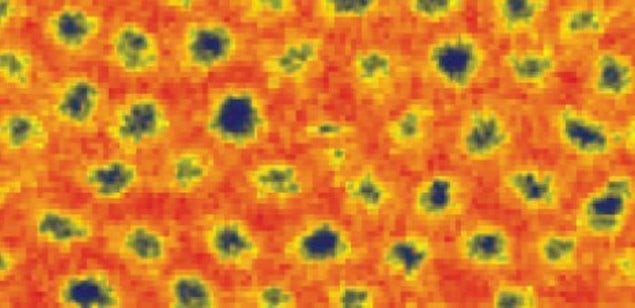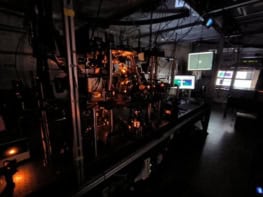
The emergence of artificial magnetic monopoles within a special magnetic material has been seen by physicists in Germany. These monopole-like defects are believed to pass through the material when tiny magnetic whorls called skyrmions coalesce. Skyrmions could have potential applications in future data-storage technologies – and this new understanding of their behaviour could be an important first step in developing this technology.
“[Our] new study shows the basic mechanism of how skyrmions may be destroyed (and thus also created),” says Christian Pfleiderer of the Technische Universität München, who was involved with the research. “As an added bonus, the mechanism corresponds topologically to magnetic monopoles – which is kind of cool.” The team also included researchers at the Technische Universität Dresden and the University of Cologne.
Skyrmions are small magnetic vortices that are known to exist in materials made of cobalt, iron and silicon. They were first spotted in 2009 by means of neutron-scattering studies. They appear as line-like structures that run parallel to the direction of an applied magnetic field. The magnetization of a skyrmion winds around the line and the skyrmions form a hexagonal lattice. While not actually magnetic fields, skyrmions can affect the motion of electrons in a manner similar to a magnetic field – which has led some physicists to describe them as an artificial magnetic field.
Winding up
Each skyrmion is said to have a non-zero “topological winding number” – which counts the number of times such a magnetic structure wraps a unit sphere. This means that the vortices cannot be easily untwisted into a normal magnetic state. “The topological winding can be thought of like a tennis-ball,” Pfleiderer explains. “No matter how you comb it there will always be a whorl that cannot be removed.” The skyrmions are named after the British particle physicist Tony Skyrme, who proposed the idea of modelling protons, neutrons and larger atomic nuclei as topological structures in a pion field condensate.
The team made its measurements on a cobalt–iron–silicon compound, which previous neutron-scattering experiments had shown to contain skyrmions in bulk. One aim of Pfleiderer and colleagues was to see if the surface pattern of the skyrmions corresponded to their layout below the surface. The researchers also wanted to work out whether there is a fundamental mechanism by which the topological winding in a skyrmion can be destroyed.
The team used a magnetic force microscope (MFM) to map out the distribution and shape of the skyrmions on the surface of the sample that was cooled to about 10 K and exposed to a magnetic field of about 20 mT. A MFM is similar to atomic force microscopy and involves placing a tiny magnetized tip very near to the surface of the sample, where it feels the local magnetic field. This allowed the researchers to map out the locations of the skyrmions, which averaged about 50 nm in diameter and were arranged about 100 nm apart in a hexagonal lattice (see image).
Coalescing into lines
The skyrmions disappeared as the magnetic field was reduced to zero, and the team made a careful study of how this occurs at a fixed temperature. The skyrmions were seen to decay by coalescing with their neighbours to form lines on the surface. At zero magnetic field, the lines created a tiger-stripe pattern. While the researchers could not see individual skyrmions within the bulk of the sample, computer simulations suggest that a similar coalescence occurs beneath the surface.
“The coalescence works like a zipper,” Pfleiderer told physicsworld.com. “At a tiny spot, the magnetization locally goes to zero. This defect propagates along the skyrmions, thereby ‘zipping’ them together.” According to Pfleiderer, the defect corresponds topologically to a magnetic monopole – a hypothetical particle with only one magnetic pole.
“The creation and annihilation of skyrmions is a vital issue from the viewpoints of both fundamental physics and technological applications,” says Naoto Nagaosa of the University of Tokyo, who was not involved in the study. Nagaosa adds that this discovery will have a significant impact on a range of physics.
Smaller and more efficient
Skyrmions could become the basis of future hard-disk technology. Today’s disks use magnetic domains to store information – and there are fundamental limits to how tiny such domains can be. However, the team believes that skyrmions have the potential to be much smaller than conventional domains. Therefore, they could be used to create storage devices with much higher density – and much less power consumption – than existing devices.
The team is now doing a systematic search for other types of materials that are capable of supporting skyrmions – which Pfleiderer suggests could be a “a rather universal property”. The researchers are also looking to develop new methods for manipulating skyrmions.
The work is published in Science.



